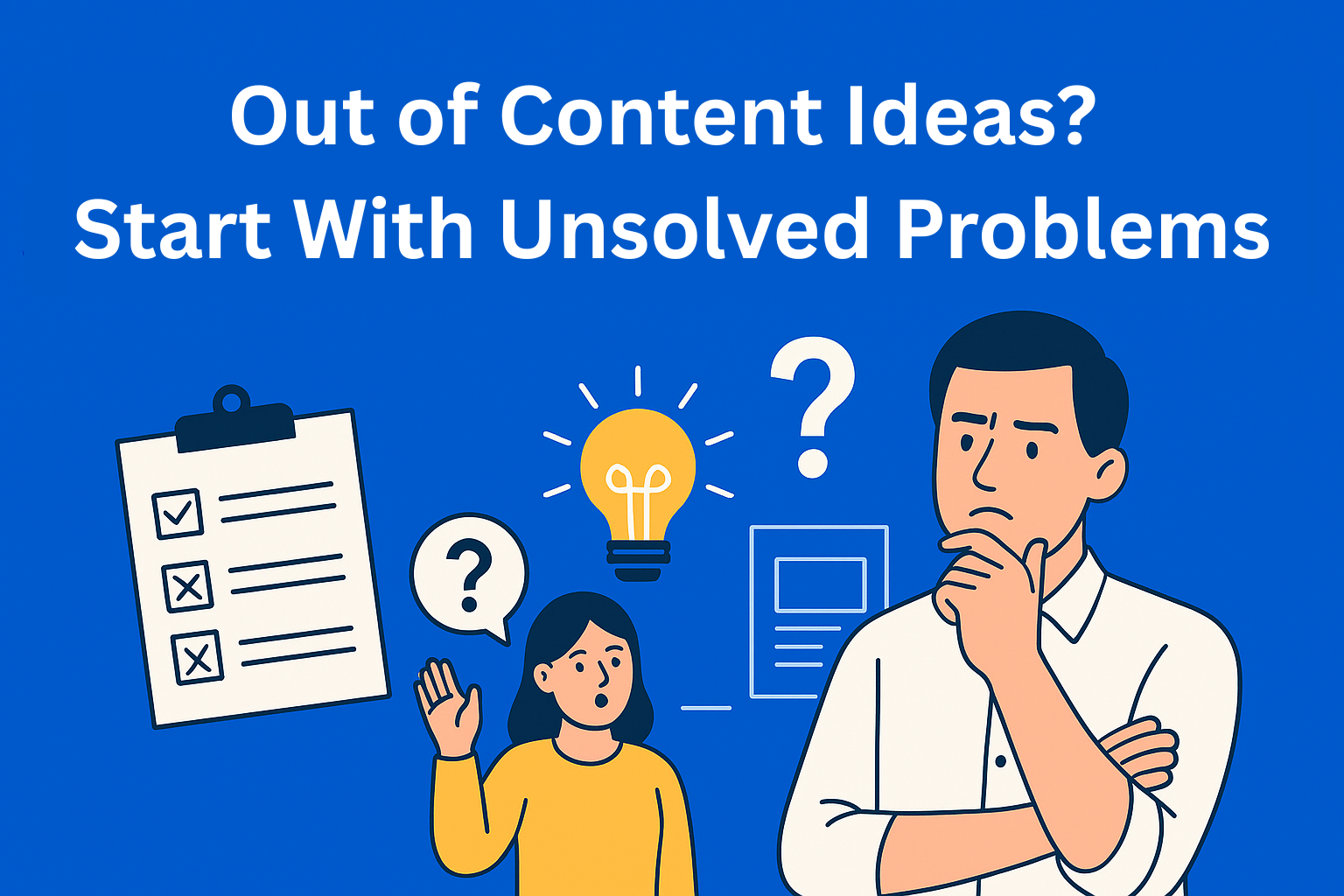When You Feel “Out of Topics” Start With the Problems You Haven’t Solved Yet
Feeling out of topics? This guide shows how to uncover your audience’s real pain points and turn unsolved problems into endless content ideas. Shift from content output to problem-solving and rediscover inspiration that actually helps your readers.

Have you ever asked yourself: “What else can I write about? I’ve said everything already!” If you have, don’t worry - it’s completely normal. Many creators, bloggers, and marketers reach that moment when it seems like they’ve run out of ideas. But the truth is, the problem isn’t that you’ve run out of topics. The real reason is that you’ve started focusing on what you’ve already said instead of what your audience is still struggling with.
When you constantly think about what you’ve already published, your brain goes into a loop. The topics start repeating, and inspiration fades away. Instead, the real source of new ideas lies in the questions your audience still doesn’t have answers to. People don’t just want information - they want solutions to their problems.
If you change your perspective and ask yourself: “What problem have my readers still not solved?” you’ll start noticing new ideas coming naturally. That’s the essence of creating content that lasts - because it focuses on real human needs.
Key Takeaways
- Feeling “out of topics” is a signal, not a dead end - It means you're focused on what you've said, not on what your audience still needs.
- Real inspiration comes from unsolved problems - Shift from creating to meet a quota, to creating to solve - that’s where lasting content comes from.
- Your audience is already telling you what to write - Comments, messages, incomplete guides, and hesitation points are gold mines for new content ideas.
- Content gaps = next content plan - Unanswered questions and half-explored ideas in your existing content can spawn entire new series.
- Every pain point can be repurposed endlessly - Turn problems into mini-series, real examples, different formats, and content that keeps on giving.
From Content Creation to Problem Solving
Most people create content for the wrong reason. They want to “put out” a new post, video, or story because they think they have to stay constantly active. That’s called the output mindset - a focus on quantity. But quantity without purpose doesn’t bring results.
Imagine your content isn’t just information but a tool that helps people solve a problem. When you see it that way, every piece you create becomes simple, clear, and useful. People don’t follow you because you write beautifully - they follow you because your work actually helps them.
Example: if you have a marketing blog, don’t write about what SEO is; write about how someone can improve SEO with no budget. That’s the problem-solving mindset. Instead of repeating known definitions, you dive into real-life situations your audience faces.
This way of thinking immediately opens up many new ideas. Every unresolved problem or unanswered question can become a new topic for an article, video, or post. That’s how you build trust and become someone your audience keeps coming back to.
How to Discover Unsolved Audience Problems
If you want to find new topics, you have to dig deeper. Here are a few simple ways to find where your audience still struggles:
1. Analyze comments and messages. People often ask the same questions repeatedly. Those are golden topics. If the same question appears multiple times, it means your audience still doesn’t have a clear solution.
2. Pay attention to moments when people stop taking action. If readers go through your guide but don’t apply your advice, there’s probably a missing piece. Maybe they need an example, a tool, or a clearer explanation.
3. Review your old posts. Very often, unfinished ideas hide in your older content. Maybe you mentioned a concept months ago but never expanded on it. That’s a new topic waiting to be written.
4. Listen to communities. Reddit threads, LinkedIn comments, Facebook groups, and even TikTok comments - these are all places where your audience openly talks about their struggles. That’s where you’ll find the topics people truly care about.
5. Use tools. Google Search Console shows what phrases people type to reach your site. AnswerThePublic reveals what questions they’re asking around your topic. This data is a treasure chest for planning content.
These steps help you discover your audience’s real pain points. When you know what hurts, you’ll know what to write about.
Spot the Gaps in Your Content
Every piece of content has gaps - parts you haven’t fully explained, topics you’ve only mentioned, or steps you’ve skipped. These gaps, or content gaps, are exactly where your next great topics hide.
Here’s how to find them:
- Look at your existing posts like a map. Does each post have a logical continuation? If you wrote about strategy, did you later explain how to put it into practice?
- Evaluate the depth of each topic. Did you provide real, actionable solutions, or did you stay on the surface? If it’s the latter, there’s room for expansion.
- Find what you’ve missed connecting. Sometimes two of your posts can be merged into a third that offers a fresh perspective.
A simple trick: make a two-column table - Audience Problem and Is It Solved in My Content? If you have many “no” answers, you’ve just created your next content plan.
When you spot those gaps, you’ll realize you’ve never actually run out of topics. You just stopped looking where the questions still exist.
Turn Pain Points Into Endless Topics
Every audience problem can become a new content idea. Here’s how to turn them into a constant source of inspiration:
1. Write mini-series. If your audience faces a complex problem, break it into parts. Instead of one article, create a series:
- The first covers the basics,
- The second gives practical steps,
- The third talks about common mistakes to avoid.
2. Use concrete examples. People learn better through real-life stories. In each piece, add a short example or case study showing how someone applied your advice.
3. Turn questions into titles. If someone asks: “How can I write when I have no ideas?” - that’s your next headline. Topics don’t have to be complicated. They just need to give a clear answer to a real question.
4. Mix formats. You don’t always have to write a blog. The same problem can be covered through a newsletter, video, Q&A post, or a short guide on social media. Each format gives a new perspective on the same topic.
When you see content as a way to help people, every new question from your audience becomes a new topic. Writing then feels natural and easy - not exhausting.
Conclusion
It’s simple - you’ll never run out of topics if you keep solving real problems for your audience.
Instead of chasing inspiration, look for obstacles. Instead of asking, “What should I post next?”, ask, “What do my readers still not understand?”
When you think this way, every idea makes sense. Your content becomes clear, useful, and authentic. People start trusting you because they can see you understand their challenges.
So next time you feel like you’ve run out of topics, remember: you’re not out of ideas - you’ve just temporarily lost focus on the problems you haven’t helped someone solve yet.






